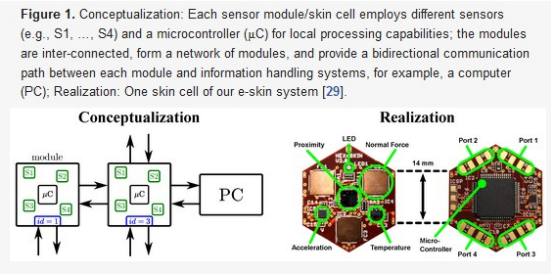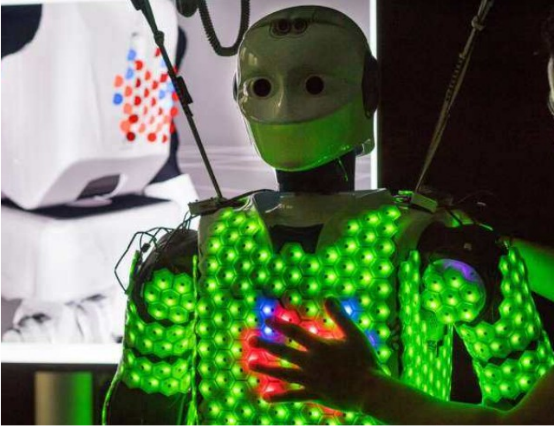What is the electronic skin of the hexagonal sensor?
Researchers at the Technical University of Munich, Germany, have recently developed an electronic skin that can help robots feel human touch. The electronic skin described in MDIT's "Sensor" magazine paper requires much lower computing power than other existing electronic skins, so it can be applied to the body of a robot in a larger area.
The sense of touch allows us to feel safer and more convenient when interacting and controlling the connection with the surrounding environment. Many technical systems and applications can benefit from similar technologies. However, although the coverage of the current electronic skin system is wider than before, there are still few cases of implementing electronic skin in a large area.
The paper stated that the upgrade of electronic skin faces new problems: the spatial relationship between sensing points is very complicated, and processing a large amount of heterogeneous tactile information in it has become a big challenge. In response to this challenge, the researchers proposed a new method to implement a flexible event-driven information processing system on a standard computer system used in large electronic skins, and described in detail the effective design of event generators and decoders.
The final system design for the electronic skin system is scalable, efficient, and flexible, and can process large amounts of information without custom hardware. This system provides the feasibility of applying complex large-area haptic systems in robotics, for example.
A hexagonal sensor the size of a 2 Euro coin constitutes an electronic skin
Florian Bergne, one of the researchers who conducted this research, said: "The main motivation for developing electronic skin is natural and focused on how we humans interact with the surrounding environment. Although humans mainly rely on vision, once it involves interaction, we The tactile sense of the robot is particularly important. We believe that giving the robot tactile sense can expand the range of interaction between the robot and the human, thereby making the robot more collaborative, safe and effective."
Bergner and other researchers led by Professor Gordon Cheng have been developing electronic skins for about 10 years. Initially, they tried to realize an electronic skin system with multi-modal sensing functions similar to human skin. In other words, they are trying to create an artificial skin that can sense light touch, pressure, temperature, and vibration, while effectively distributing its perception in different locations where tactile interaction occurs.
Bergner said: "Humans can not only distinguish the touch of different kinds of objects, but also distinguish their positions. In addition to duplicating this function, the electronic skin system should also withstand the pressure of physical contact, be scalable, and combine each object with minimal power. These functions are integrated."
The new electronic skin system developed by Bergner and colleagues consists of hexagonal sensing modules. Each module is about the size of a 2 Euro coin. When they are connected together, a soft artificial skin or skin patch is formed, which can be attached to a variety of flat or curved surfaces.

Hexagonal sensor module about the size of a 2 Euro coin
Sleep mode reduces the demand for computing power for system operation
So far, electronic skins that can be applied to a large surface area still have obvious limitations in the amount of touch information they can detect at one time. On the other hand, the electronic skin system developed by Bergner and his colleagues retains its advanced sensing function without consuming a lot of computing power.
Bergner said: "Traditional information processing has unacceptably high requirements for computing power, high power consumption, high information transmission rate, information loss and delay. On the other hand, humans can handle about 5 million without any effort. Tactile information collected by skin receptors. In recent research, we asked ourselves how does the human sense of touch do this? How can we use research to discover neuroscience to alleviate the limitations of our electronic skin?"
The receptors on the human skin tend to remain inactive before detecting changes in touch pressure, temperature, or vibration, rather than constantly sending information to the brain. When they detect a change, these receptors trigger a spike, which transmits the change to the brain through nerve fibers.
The result of this process is that humans provide new information related to touch to the brain through the skin. Bergner and his colleagues conducted an in-depth study of the biological process and tried to replicate the process into their electronic skin.
Bergner explained: "In our system, every artificial skin cell monitors its sensor to detect changes. When they detect a large enough change, the skin cells report new information to the computer, otherwise they will Enter sleep mode. This operation greatly reduces the demand for computing power for system operation."

Diagram of skin cell formation in the electronic skin system
Each sensor module or skin unit uses different sensors (such as S1,..., S4) and the processing power of a microcontroller (μC); these modules are connected to each other to form a module network, and each module is connected to information processing A two-way communication path is provided between systems (such as computers) to form a skin cell of the electronic skin system.
Cover the robot with more than 10,000 sensors, reducing the amount of calculation by 80%
Bergner and colleagues successfully applied their electronic skin to a human-sized robot, H1. The system is able to use 1,260 skin cells to cover the entire body, including more than 10,000 sensors, which has never been done before.

The H1 robot developed by the researchers wears an electronic skin
Bergner said: "The H1 robot can only be operated automatically through an onboard system. Only by taking advantage of our electronic skin driven in a new form, it is possible to cover the H1 with skin cells. The electronic skin reduces the amount of calculation by about 80%. The more traditional electronic skin will completely saturate the H1 system, which will cause delays and approximately 25% of continuous information loss."
In the future, efficient electronic skins can provide more powerful touch functions for various robots. This type of electronic skin can increase the safety of human-computer interaction, which is particularly valuable in the industrial and medical fields. In addition, electronic skin cells can also be used to develop new technical tools, such as touch-sensitive prostheses, smart objects or sensor clothing.
Bergner said: "After solving the problem of processing the tactile information of a large area of electronic skin, we can now consider reducing the size of skin cells to achieve a higher sensing density. H1 is covered with a large area of electronic skin, and we can use It is used to study human-computer interaction and whole-body control. Another interesting research direction may be the study of tactile information driven in new forms to enhance perception and control algorithms."
If you want to know more, our website has product specifications hexagonal sensor, you can go to ALLICDATA ELECTRONICS LIMITED to get more information

